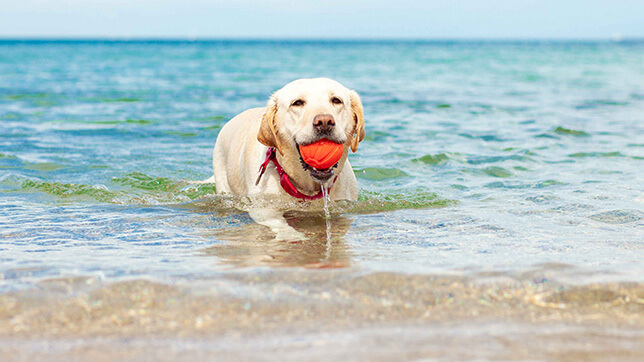26th October 2021
As the weather gets warmer many dogs (and some cats) will enjoy taking a swim to cool off. While a paddle in a pond might seem harmless, there are many hidden dangers that your pet could encounter. Here we discuss some of the waterborne hazards for dogs and how to spot whether your pet has been affected. According to our data, around 388 UK pets drowned in 2015*, so it’s crucial to take safety into account when your pets are cooling off.
Waterborne illnesses
There are various organisms present, particularly in stagnant or marshy water, which can cause harm to your pet or even yourself. The majority of waterborne illnesses cause diarrhoea which is itself treatable, but does need further investigation as different parasitic infestations require rather different treatment. Unfortunately there is no one-size-fits-all approach.
If your pet does swim in water that is stagnant (in other words a pond or lake) there is a risk of them picking up a parasite, many of which are transmitted by ingestion or skin contact. Some of these infections are zoonotic, meaning they can be passed on to humans too. Generally these illnesses are not life threatening as long as they are caught and treated in a timely manner, but in young or immunocompromised pets they can prove a lot more serious. This is especially true of leptospirosis which can spread to the liver.
Unless you stop your pet from swimming altogether, it’s difficult to totally prevent them from contracting one of these illnesses. Ideally though, you should avoid still waters and favour slow-moving rivers or streams as infections are less likely to linger in flowing water. Also, try to ensure that you always have water on hand for your pet to drink so they won’t feel the need to drink from stagnant pools. Practice good basic hygiene and, if your pet shows symptoms, seek veterinary advice and remember to state that your pet has been swimming.

Aquatic animals
It might seem a little dramatic to suggest that your pet could be at threat from fish, but you’d be surprised. Pike in particular can grow to be very large indeed and could certainly pose a risk to small dogs or puppies. There have also been cases of river rats attacking dogs. Stay vigilant and keep an eye out for any potential predators.
Strong currents
While rivers, streams and seas have the benefit of being clearer of parasites, running water can be misleadingly fast. A look at the surface of the water might indicate that the current is gentler than it really is. Be sure to avoid letting your pet swim in rivers that are very full, for example after heavy rainfall, and keep them away from the sea if there are riptide warnings in effect.
Unusual objects
The old comedy routine of fishermen pulling boots out of the water has some basis in fact. Nature groups are often warning about the increasing levels of litter and waste accumulating in our waterways, with assorted objects finding their way into the water. Cans, bottles, rocks and other sharp objects could cut your pet while swimming, and reeds or rope could cause them to become entangled. To avoid this, keep them out of muddy, dark or polluted water. If they do cut themselves seek veterinary attention, as the wound is more likely to get infected if they have been in water that isn’t very clean.
Tiredness
If your dog is very old, very young, or gets tired easily it is important to monitor their swimming to make sure they aren’t getting out of their depth. While many dogs will approach an activity with enthusiasm it could prove fatal if they swim out further than they are able to swim back. Don’t let your dog swim too far from the bank or shore, and keep an eye out to make sure they aren’t overtired.
Swimming is a great activity that can help your pets to stay cool and get a slightly different form of exercise. As long as you are cautious and sensible you and your pet should be able to have fun and stay safe in the water.
*Based on number of claims we saw for drowning on 2015, extrapolated over the entire pet population in that year.
More on our dog blog
Read more news articles, opinion pieces, reviews and personal stories behind our dogs on our blog.
Need dog insurance?
Dog insurance can help cover the cost of veterinary treatment if your dog gets injured or falls ill.
We know pets
Our pets are part of the family. To achieve our vision of a better future for pets everywhere, we work with our partners, vets, and other veterinary professionals who are pioneering the latest advancements in animal care. Our campaigns, articles, and events are crafted to support, educate, and celebrate pet owners, while our policies are designed to provide peace of mind at an affordable price.
Yet our policies don’t just protect against the unexpected – they have purpose, too.
Since we were founded over 25 years ago, we've provided industry-leading policies that protect the nation’s pets, while also making a difference to animal welfare and our planet. Thanks to you, our policyholders, we've donated over £9 million to more than 830 animal welfare charities and conservancies, helping to support vulnerable pets and wildlife around the world.
We’re proud to be wildly different. Are you?
